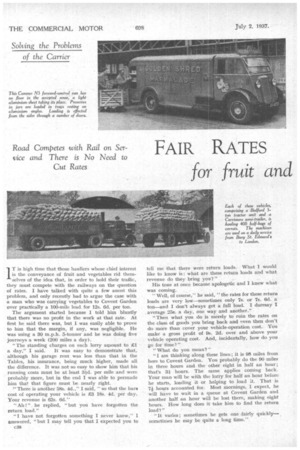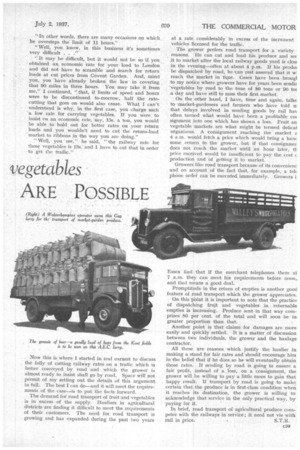FAIR RATES for fruit and
Page 84

Page 85

If you've noticed an error in this article please click here to report it so we can fix it.
vegetables ARE POSSIBLE
Road Competes with Rail on Service and There is No Need to Cut Rates 1 T is high time that those hauliers whose chief interest is the conveyance of fruit and vegetables rid themselves of the idea that, in order to hold their traffic, they must compete with the railways on the question of rates. I have talked with quite a few anent this problem, and only recently had to argue the case with a man who was carrying vegetables to Covent Garden over practically a 100-mile lead for 12s. 6d. per ton.
The argument started because I told him bluntly that there was no profit in the work at that rate. At first he said there was, but I was easily able to prove to him that the margin, if any, was negligible. He was using a 30 m.p.h. 5-tanner and he was doing five journeys a week (200 miles a day).
"The standing charges on each lorry amount to £1 a day," I said. It was easy to demonstrate that, although his garage rent was less than that in the Tables, his insurance, being much higher, made all the difference. It was not so easy to show him that his running costs must be at least 3/d. per mile and were probably more, but in the end I was able to persuade him that that figure must be nearly right.
." There is another 58s. 4d.," I said, "so that the bare cost of operating your vehicle is £3 18s. 4d. per day. Your revenue is 62s. 6d."
"Ali 1 " • he replied, " but you have forgotten the return load."
"I have not forgotten something I never knew," I answered, "but I may tell you that I expected you to c38 tell me that there were return loads. What I would like to know is : what are these return loads and what revenue do they bring you?" His tone at once became' apologetic and I knew what was coming. "Well, of course," he said, "the rates for these return loads are very low—sometimes only 7s. or 7s. a ton—and I don't always get a full load. I daresay I , average 25s. a day, one way and another." "Then what you do is merely to ruin the rates on the class of goods you bring back and even then don't do more than cover your vehicle-operation cost. You make a gross profit of 9s. 2d. over and above your vehicle operating cost. And, incidentally, how do you go for time?"
"What do you mean?" "I am thinking along these lines; it is 98 miles from here to Covent Garden. You probably do the 90 miles in three hours and the other eight in half an hour; that's 3i hours. The same applies coming back. Your man will be with the lorry for half an hour before he starts, loading it or helping to load t. That is 71 hours accounted for. Most mornings, I expect, he will have to wait in a queue at Covent Garden and another half an hour will be lost there, making eight hours. How long does it take him to find the return load?"
"It varies ; sometimes he gets one .fairly quickly— . sometimes he may be quite a long time."
"In other words, there are many occasions on which he oversteps the limit of 11 hours."
"Well, you know, in this business it's sometimes very difficult . . ."
"It may be difficult, but it would not be So if you obtained an economic rate for your load to London and did not have to scramble and Search for return loads at cut prices from Covent Garden. And, mind you, you -have already broken the law in covering that 90 miles in three hours. You may take it from me," I continued, "that, if limits of speed and hours were to be discontinued to-morrow, half the ratecutting that goes on would also cease. What I can't understand is why, in the first case, you charge such 'a low tate for carrying vegetables. If you were to insist on an economic rate, say, 15s, a ton, you would be able to hold out for better rates on• your return loads and you wouldn't need to cut the return-load market to ribbons in the way you are doing."
" Well, you see," he said, "the railway rate for those vegetables is 13s. and I have to cut that in order to get the traffic."
Now this is where I started in real earnest to discuss the folly of cutting railway rates on a traffic which is better conveyed by road and which the grower is almost ready to insist shall go by road. Space will not permit of my setting out the details of this argument in full. The best I can do—and it will meet the requirements of the case—is to put the facts forward. .
The demand for road transport of fruit and vegetables is in excess of the supply. Hauliers in agricultural districts are finding it difficult to meet the requirements of their customers. The need for road transport is growing and has expanded during the past two years at a rate considerably in excess of the increment vehicles licensed for the traffic.
The grower prefers road transport for a variety reasons. He can cut and load his produce and ser it to market after the local railway goods yard is clos( in the evening—often at about 4 p.m. If his produ( be dispatched by road, he can rest assured that it wi reach the market in time. Cases have been-brougl to my notice where growers have for years been sendit -vegetables by road to the tune of 80 tons or 90 tot a day and have still to miss their first market.
On the other hand, I have, time and again, talke to market-gardeners and farmers who have told a that delays involved in sending goods by rail hal. often turned what would have been a profitable cot signment into one which has shown a loss. Fruit an vegetable markets are what might be termed delical organisms. A consignment reaching the market a 4 a.m. would fetch a price which would bring a hanc some return to the grower, but if that consignmer does not reach the market until an hour later, th price received would be insufficient to pay the cost c production and of getting it to market.
Growers like road transport because of its convenienc and on account of the fact that, for example, a telt phone order can be executed immediately. Growers
Essex find that if the merchant telephones them at .a.m. they can meet his requirements before noon, and that means a good deal.
Promptitude in the return of empties is another good feature of road transport which the grower appreciates. On this point it is important to note that the practice of dispatching fruit and vegetables in returnable empties is increasing. Produce sent in that way comprises 80 per cent. of the total and will soon be in greater proportion than that.
Another point is that claims for damages are more easily and quickly settled. It is a matter of discussion between two individuals, the grower and the haulage contractor.
All these are reasons which justify the haulier in making a stand for fair rates and should encourage him in the beliefthat if he does so he will eventually obtain those rates. If sending by road is going to ensure a fair profit, instead of a loss, on a consignment, the grower will be willing to pay a little more to gain that happy result. If transport by road is going to make certain that the produce is in first-class condition when it reaches its destination, the grower is willing to acknowledge that service in the only practical way, by paying for it.
In brief, road transport of agricultural produce competes with the railways in service; it need not vie with rail in price. •




















































































































































